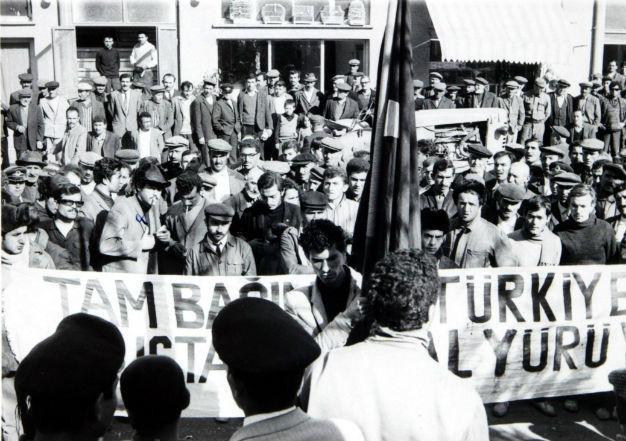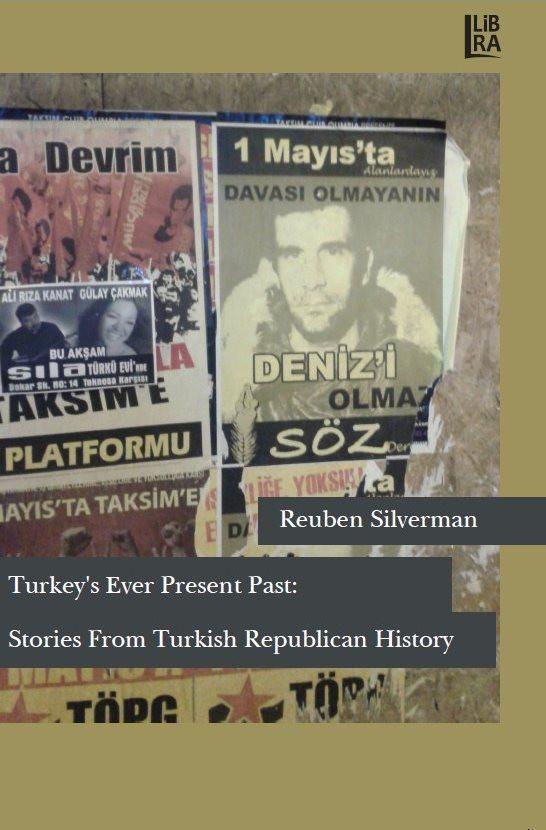Turkey’s ever present past
William Armstrong - william.armstrong@hdn.com.tr

Student revolutionary Deniz Gezmiş speaks at a march in Çorum staged by left-wing groups on Nov. 1, 1968.
‘Turkey’s Ever Present Past: Stories from Turkish Republican History’ by Reuben Silverman (Libra Books, 242 pages, $45)This is a very enriching collection of essays on modern Turkish history. Over 12 chapters, Reuben Silverman addresses a potpourri of subjects including popular music, film, literature, left and right-wing politics. The essays are drawn from pieces that Silverman, a PhD student at UC San Diego, originally posted on his personal blog. Each chapter is judicious and balanced, written with clarity and even a little panache. The author has a seemingly encyclopedic knowledge of contemporary Turkey; even a jaded observer will find something to learn from every page.
 Silverman says his book aims to focus mainly on two sets of people: “Those who have attempted – often unsuccessfully – to bring their imagined Turkey to life, and those forced to live in the world that resulted.” The country’s modern history can be seen as the story of how various groups, in the face of an immensely complex society, have attempted to impose their own vision of the “real” or “authentic” Turkey. But the process of creation has never gone smoothly. “The story of ‘Turkey’ could just as easily be that of diverse peoples actively resisting and negotiating with the state as it attempts to mold them,” Silverman writes.
Silverman says his book aims to focus mainly on two sets of people: “Those who have attempted – often unsuccessfully – to bring their imagined Turkey to life, and those forced to live in the world that resulted.” The country’s modern history can be seen as the story of how various groups, in the face of an immensely complex society, have attempted to impose their own vision of the “real” or “authentic” Turkey. But the process of creation has never gone smoothly. “The story of ‘Turkey’ could just as easily be that of diverse peoples actively resisting and negotiating with the state as it attempts to mold them,” Silverman writes. The book is divided into three main sections: “The Early Turkish Republic” (1923-1950), “Years of Democracy and Violence” (1950-1980), and “Truth and Reconciliation” (1980 to the present). The chapters focus on seminal figures of the past 100 years such as author Sait Faik Abasıyanık, Kurdish musician Ahmet Kaya, filmmaker Yılmaz Güney, Marxist-Leninist student revolutionary Deniz Gezmiş, and hard-line nationalist ideologue Kemal Kerinçsiz. Carefully drawn pen portraits of these characters are used as windows to explore a wider issue. Silverman has interesting things to say throughout, as he roams across an impressive array of subjects.
Taken together the 12 chapters amount to a colorful picture of modern Turkey – not complete but richly impressionistic. The book’s rather fragmented nature actually fits into its broader ambition - to resist any single narrative and to reflect the multiplicity of its subject. As Montaigne wrote, life is “entirely made up of bits and pieces, woven together so diversely and shapelessly that each one of them pulls its own way at every moment.” In “Turkey’s Ever Present Past,” you get a sense of the unsummarizable, almost incomprehensible sprawl of the country – a sprawl that various actors are constantly trying to fit into narrower categories and preconceptions.
But for all that variety, there is a lacuna at the center of the book: Women. Of course, Turkey’s public sphere has generally been the domain of men, but barely mentioning women is a strange oversight from an otherwise sensitive book. It is particularly glaring as Silverman says he aimed to examine the Turkish Republic from the perspective of those “constrained by another person’s metaphor, by a historical narrative crafted by someone else.”
Nevertheless, there is still much to learn from “Turkey’s Ever Present Past.” Its publisher Libra Books is tiny, running very small print runs of its various titles. But if you can track down a copy of this book you should certainly do so. If not, you can always just feast on the archive of Silverman’s website. As well as much else, it still has the original pieces from which much of this book is formed.
*Follow the Turkey Book Talk podcast via iTunes here, Stitcher here, Podbean here, or Facebook here.










